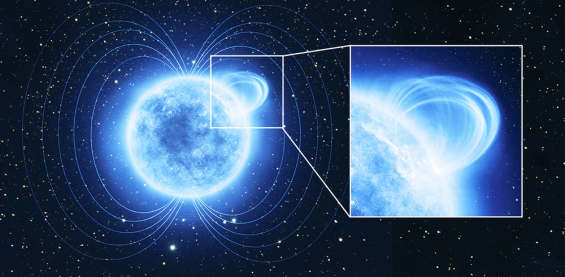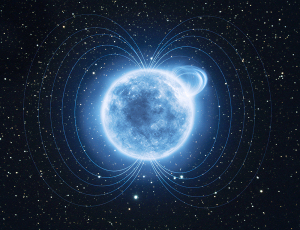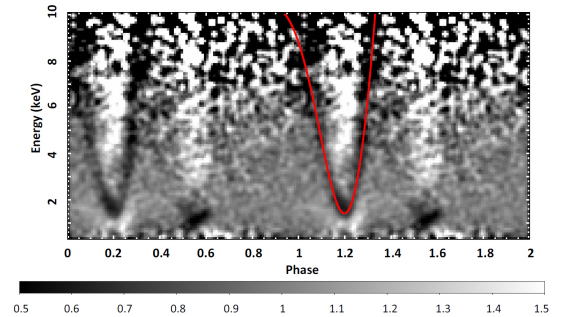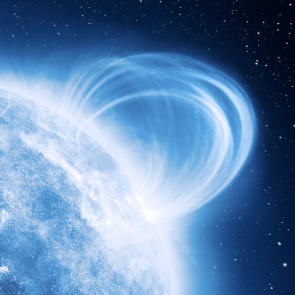Weakling magnetar reveals hidden strength
14 August 2013
Astronomers using ESA's XMM-Newton have measured the magnetic field in a small surface feature of a magnetar - a highly magnetised pulsar - for the first time. Until now, only the dipolar magnetic field of magnetars had been measured. With a new technique, the astronomers have now revealed a strong, localised surface magnetic field in the magnetar that had the lowest measured dipolar field. The discovery yields conclusive proof that magnetars conceal some of the strongest magnetic fields in the Universe.
 |
|
Magnetar |
Magnetars are peculiar pulsars – the spinning remnants of massive stars – that are characterised by unusually intense magnetic fields. Astronomers discovered them through their exceptional behaviour at X-ray wavelengths, including sudden outbursts of radiation and occasional giant flares. These peculiar features of magnetars are caused by their extremely strong magnetic fields, which range between 1014 and 1015 Gauss (G) and are hundreds or thousands of times more intense than those of regular pulsars.
Only a few years ago, the X-ray source
A new study based on data from ESA's XMM-Newton X-ray Observatory has finally found evidence to confirm this early claim. As suspected, this magnetar had been concealing, in its interior, a very strong magnetic field. The secret was uncovered when Andrea Tiengo (from the Istituto Universitario di Studi Superiori in Pavia, Italy) and colleagues detected signs of this field leaking, through a small-scale magnetic structure, from the interior to the surface of the magnetar. The study is published in the journal Nature.
"This is the first time that the magnetic field in a small region on the surface of a magnetar could be estimated," comments Tiengo.
The magnetic field estimated by Tiengo and his collaborators may even exceed 1015 G, removing any lingering doubts about the object's true identity. If this is the case, it is among the strongest magnetic fields ever observed in the Universe.
"It's also the first robust proof of the theoretical model that was developed over the past two decades to explain the intriguing behaviour of magnetars," he adds.
 |
|
Artist's impression of magnetar |
The magnetar model explains outburst and flares as a result of an exceptionally strong internal magnetic field with intricately twisted field lines. The warped magnetic field builds up stress below the magnetar's surface, occasionally breaking its crust apart and releasing sudden bursts of X-rays.
The magnetic field of a magnetar manifests itself at different levels. At first sight, the most obvious effect is a dipole field, which is usually very intense. A magnetar's dipolar magnetic field can be easily estimated by monitoring its spinning period since this magnetic field slows down the rotation of the star. Measuring the spin-down rate, or how its rotation period slows down, yields an estimate of the underlying magnetic field.
But
"We searched for more subtle effects: for example, the strong magnetic field may reveal itself only on a very small portion of the magnetar's surface," explains Tiengo.
For this reason, the team of astronomers developed a new technique to analyse the data and look for a signature of a strong but confined magnetic field.
"We studied how the magnetar's X-ray emission varied at different energies and, at the same time, as a function of the star's rotational period.
"This allowed us to search for possible changes in the emission that are localised to smaller portions of the magnetar's surface."
The astronomers could apply this technique by exploiting XMM-Newton's great energy and time resolution, as well as the high sensitivity that can be attained with the observatory's large effective area.
"The result was uncanny: at regular intervals during its 9-second rotation, the magnetar's emission declined at certain energies.
 |
| Cyclotron absorption reveals magnetar's local magnetic field. Credit: Image courtesy of A. Tiengo. From Tiengo et al. 2013, Nature |
"This indicates that some of the X-rays emitted by the star were being absorbed by particles that were located only in a well-confined region of the magnetar."
The phenomenon detected by Tiengo and his colleagues, called cyclotron absorption, is caused by protons that interact with the X-rays emitted by the magnetar. These interactions happen at energies between 1 and 5 keV, depending on the specific intensity of the magnetic field at the place of interaction.
The regular dimming of the magnetar's emission at these energies, caused by cyclotron absorption, revealed a higher than average concentration of protons. These were localised over a portion of the magnetar's surface spanning a mere few hundred metres across – quite small even compared to the magnetar's modest radius of about 10 km.
"The protons were confined there by a strong, localised magnetic field emerging from the magnetar's interior: this confirms our previous hypothesis that
 |
|
A magnetic loop on the magnetar |
From the small variation in the energy of the observed cyclotron absorption, the astronomers were able to model the magnetic field in this very small patch of the magnetar's surface. The magnetic field lines are probably shaped like a series of adjacent arcs, resembling the appearance of loops on the surface of the Sun.
"We suspected that the internal magnetic field of this magnetar might reveal itself through such a 'magnetic loop', but didn't expect that it would have such a clear observational signature," says Tiengo.
It was this magnetar's peculiar weakness – its unusually low dipolar magnetic field – that made it easier to single out this small magnetic structure, as the effect of the strong field localised in a small patch of its surface stood out clearly against its weak background. The astronomers are now applying the same technique to try to identify similarly small magnetic structures on the surface of other magnetars, although the contrast might not be as good in other cases and the detection might prove harder.
"This discovery finally proves that magnetars harbour the strongest magnetic fields to be found in the present-day Universe," comments Norbert Schartel, XMM-Newton Project Scientist at ESA.
"This also confirms that any pulsar might conceal such a strong magnetic field in its interior without displaying it as a strong dipole field. As a result, all pulsars may switch on and become magnetars for a while – which is a new idea we've been considering since this magnetar was first identified."
Background information
The results described in this article are reported by A. Tiengo and colleagues in the paper "A variable absorption feature in the X-ray spectrum of a magnetar", published in Nature, 15 August 2013.
The study is based on X-ray data of the magnetar
The European Space Agency's X-ray Multi-Mirror Mission, XMM-Newton, was launched in December 1999. It is the biggest scientific satellite to have been built in Europe and uses over 170 wafer-thin cylindrical mirrors spread over three high throughput X-ray telescopes. Its mirrors are among the most powerful ever developed. XMM-Newton's orbit takes it almost a third of the way to the Moon, allowing for long, uninterrupted views of celestial objects. The scientific community can apply for observing time on XMM-Newton on a competitive basis.
Related publications
A. Tiengo, et al., "A variable absorption feature in the X-ray spectrum of a magnetar", 2013, Nature, 500, 312
N. Rea, et al., "The outburst decay of the low magnetic field Magnetar
N. Rea, et al., "A low-magnetic-field soft gamma repeater", 2010, Science, 330, 944
Contacts
Andrea Tiengo
Istituto Universitario di Studi Superiori and Istituto Nazionale di Fisica Nucleare
Pavia, Italy
and Istituto di Astrofisica Spaziale e Fisica Cosmica/INAF
Milan, Italy
Email: andrea.tiengo![]() iusspavia.it
iusspavia.it
Phone: +39-0382-375865; +39-02-23699-468
Norbert Schartel
ESA XMM-Newton Project Scientist
Directorate of Science and Robotic Exploration
European Space Agency
Email: Norbert.Schartel![]() esa.int
esa.int
Phone: +34-91-8131-184




